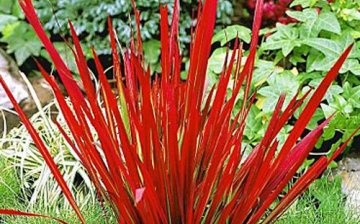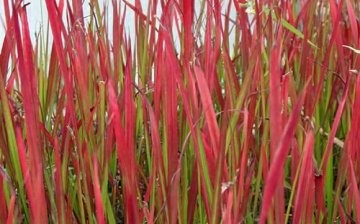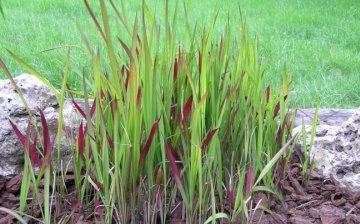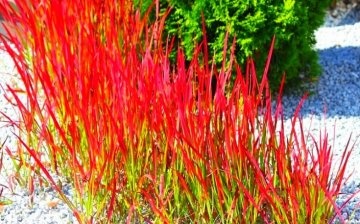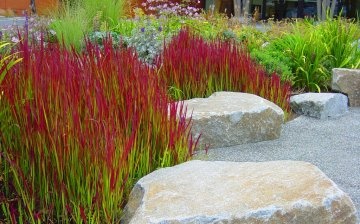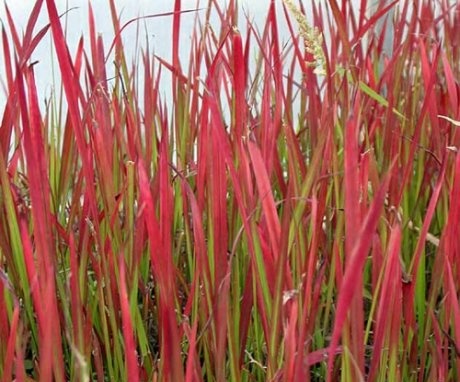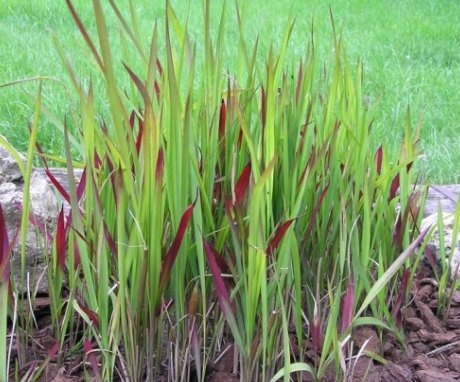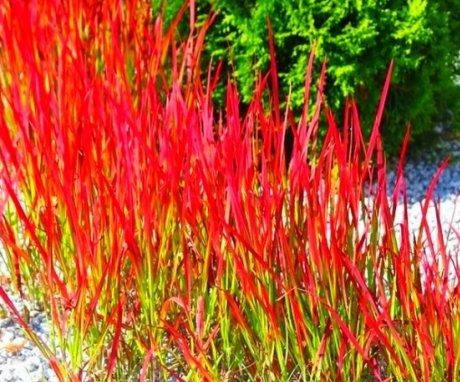How to grow an Emperor Cylindrical in a garden?
Imperata is a species of ornamental plants from the Gramineae family. The most famous is the Imperata Cylindrica, which is actively used by landscape designers. Gardeners prefer to choose the Cylindrical Emperor because of the ease of cultivation and spectacular appearance, which is able to diversify the panorama of the garden. For the special shape and color of the leaves, as well as for their clear arrangement among the people, the culture was nicknamed "Red Lightning".
In natural conditions of growth, the Imperata is known as a weed that grows rapidly, filling the vacant land. The thickets of these cereals are difficult to overcome, and due to their rigid structure, they are not eaten by any animals. As it spreads, the culture displaces all greenery, which makes it difficult for birds to nest, and hard, sharp leaves injure animals.
Today, the plant can be found in almost all warm regions, but the spread of the Impera began from China and Japan. Due to its extensive distribution, the culture is called differently: kogon grass, alang-alang, kazaro, Imperata Reed, Red bloody Japanese grass.
Content:
- Imperial cylindrical appearance
- How to propagate and transplant a plant
- Organization of proper care
- The emperor as a garden decoration
Appearance of the impera cylindrical
Imperata Cylindrical refers to perennial plants with hard and traumatic leaves. The leaf plates flaunt on tall stems, and because of their shape they are often compared to the blade of a knife.
The crop can grow up to 80 cm in height and look beautiful in bloom - although this is a fairly rare phenomenon.
In landscape design, the "Red Baron" variety is especially popular - a very effective cereal with upright erect leaves, which grows up to half a meter. Young foliage has a bright green color with red tips, the color of which becomes more intense towards the end of the season. As the Emperor grows up, the leaves become completely scarlet, and in the bright sun - almost burgundy. This feature favorably distinguishes the plant among ornamental grasses.
The "Red Baron" is not characterized by flowering and seed formation. But very rarely you can still see its flowering in the form of fluffy silver spikelets, which make an advantageous contrast with the leaves.
How to propagate and transplant a plant
In order for the plant to always remain decorative, it is important to correctly select the area where it will grow and follow the recommendations of specialists:
- The place where it is planned to plant the Cylindrical Emperor must have a good lighting from morning to evening. It is sunlight that contributes to the production of the distinctive red pigment for which the plant is grown.
- The soil does not play a special role, the main thing is that it has good drainage capacity. Moisture stagnation should not be allowed, otherwise the roots may rot.
- To plant plants, you need to dig a hole that is twice the size of the roots. A layer is laid on the bottom of the pit mineral fertilizers... A plant is placed in the center of the hole and covered with soil, tamping it layer by layer.After planting, the plant needs to be watered, and the soil around it mulch.
- The cereal culture is quite frost-resistant, but in fact it is thermophilic. Favorable conditions for growth are air temperatures in the range of 22-28 degrees with relative humidity.
Reproduction of the Emperor is carried out by dividing the rhizome of adult representatives, which have managed to grow significantly and thinned out in the center. Spring is a good time for separation. To carry out the procedure, you should perform a number of actions:
- the bushes carefully dig up and cut the root system into several parts
- holes are dug under the planting material, 15-20 cm deep, the bottom of which is fertilized with mineral compounds
- planting planting material
If the procedure is carried out correctly and the roots of the plant were not damaged, then within a month several more young bushes of the Cylindrical Emperor will flaunt on the site.
Organization of proper care
Imperata Cylindrical is distinguished by its unpretentiousness and does not cause problems to its owner. But it is important to restrain the violent nature of the plant so that it does not grow throughout the site and follow several recommendations:
- At the end of each season, you need to spend pruning cereal bushes, leaving about ten centimeters above the ground.
- Cut out purely green shoots so that the culture does not degenerate.
- Bushes that have lost their decorative effect need to be dug up and rejuvenated by dividing.
- In dry weather, the plant needs moderate but regular watering, which should be discontinued after colder weather sets in.
- As for dressings, it is enough to apply them twice during the whole season. Imperata has a positive attitude towards complex mineral fertilizerswhich can be purchased at flower shops. If the soils on which the plants grow are fertile enough, then feeding is not necessary.
- Another advantage of ornamental cereal is its strong immunity to diseases and pests. Due to the tough foliage, harmful insects prefer to bypass plants. The only thing that a culture can hurt is root decay, which can be easily avoided by observing watering regimes.
A common problem that a gardener may face is freezing of the crop in winter with a lack of snow cover. If the climate in the region is changeable, then it is advisable to cover the plants for the winter with spruce branches.
When replanting a plant, you need to provide stable irrigation so that the soil is moist for two to three weeks.
This is explained by the fact that it is quite difficult for the Emperor to take root, and moisture helps her to get used to it. In order to prevent root rotting, planting holes should be equipped with high-quality drainage, which will remove excess moisture from the plant root system.
The emperor as a garden decoration
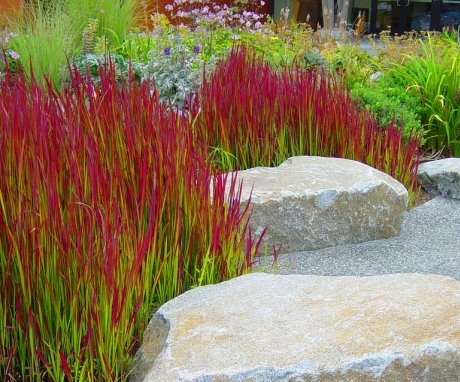
Landscape designers actively use "Red Lightning" in various compositions (it looks especially impressive on areas stylized as Japanese gardens):
- No less effect can be achieved if you use bright cereal when decorating mixborders in order to highlight accents in a decorative composition. When planted with islands, the Imperata looks good with cereals of silvery and yellow shades.
- The fiery red bushes fit perfectly into compact gardens with variegated deciduous plants. When, at the end of the season, many plants part with their decorativeness, Imperata Cylindrical retains a bright colorful appearance and takes the main place in the composition, revitalizing fading colors.
- Also, the plant is favorably set off by bright green conifers and large-leaved shrubs. It goes well with low-growing ground cover and creeping crops, standing out against their background with a colorful speck.Compositions of the Imperata with yellow-leaved jasmine, cypress, fieldfare, variegated barberry are beautiful.
- The heat-loving culture is also successfully cultivated in cold climates, planting variegated bushes in containers, which are moved to the premises of the winter garden during frosts.
- Imperata Cylindrical is an ideal option for decorating artificial reservoirs, creating the illusion of a fabulous lake. In addition to decorativeness, it is able to secure the reservoir, especially if children often play on the site. After all, hard sharp leaves are capable of sensitively scratching the skin and discouraging small fidgets and pets from approaching it.
- Also, these decorative cereals are used in bouquet compositions and in the preparation of winter herbaria.
When planting the Emperor in the garden, it should be remembered that with a rapid growth rate, the plant develops slowly and the colorful cereal will reach its greatest decorative effect only by the fourth year of life. But this is more a plus than a minus. After all, the culture is gradually changing its colors and every year the garden will look individual.
In addition to the decorative qualities of the Emperor, it also has healing properties.
Decoctions of its rhizomes are used by folk healers to treat liver, stomach and kidney diseases, as well as the respiratory system, tonsillitis and colds. Therefore, planting the Emperor in a garden plot, flower growers also acquire a universal home first aid kit.
When decorating garden plots with decorative cereals, you can ensure their colorfulness from early spring to late autumn. Indeed, even when dried, the cereals do not lose their decorative effect. And the versatility of the application is able to fit perfectly into any design, with various motives.
More information can be found in the video:



